I chose to dissect this card due to a number of reasons, or actually, words that we see in the text: exile, cast, sacrifice and regenerate. Each of these terms deserves attention on its own. However, the most interesting about this card is its triggered ability.
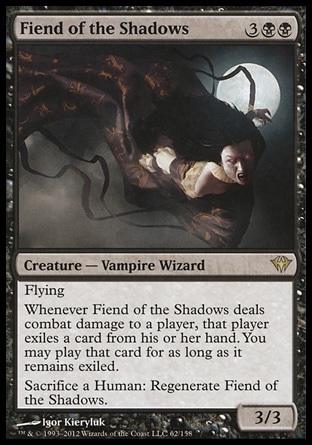
Oracle Text:
Creature — Vampire Wizard
Flying
Whenever Fiend of the Shadows deals combat damage to a player, that player exiles a card from his or her hand. You may play that card for as long as it remains exiled.
Sacrifice a Human: Regenerate Fiend of the Shadows.
First things first!
Fiend of the Shadows is a black creature with two subtypes: Vampire and Wizard. The most important thing to remember about subtypes is that a subtype of any card except Plane cards is a single word. Our guest counts as both Vampire and Wizard that means that Olivia Voldaren can “steal” it with her last ability, and casting Fiend of the Shadows will also trigger Inspired Sprite’s ability. When Door of Destinies resolves you are requested to choose a creature type. If you plan to get some bonuses for Fiend of the Shadows, you may choose one of its types, but not both! There is no Vampire-Wizard type.
Fiend of the Shadows has Flying.
Fiend of the Shadows’s second ability is a triggered one. It triggers when Fiend of the Shadows deals combat damage to a player.
Combat damage is only the damage dealt by attacking or blocking creatures during the turn-based action of dealing damage during combat damage steps. You may, for example, equip Fiend of the Shadows with Wolfhunter’s Quiver, block with it and activate its ability to damage the opponent during combat damage step, but this damage won’t be considered combat damage and Fiend of the Shadows ability won’t trigger.
If the ability triggered and was put on the stack, on its resolution the damaged player would have to exile a card from his or her hand. If the hand is empty, this effect is ignored.
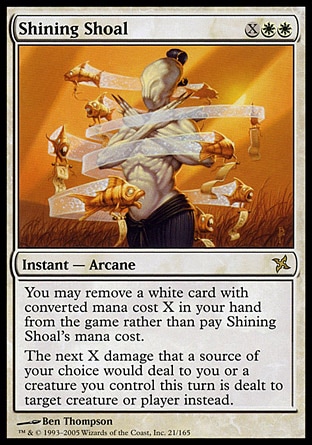
It’s absolutely unnecessarily that the player that was dealt combat damage by Fiend of the Shadows is the same player she attacked. Combat damage may be redirected! Cunning opponent may choose to target you with his Shining Shoal, if he does, you’ll have to exile a card from your own hand.
If as a result of redirection Fiend of the Shadows deals combat damage to more than one player, her ability will trigger for each player that was dealt damage this way.
Let’s now study “exile”.
Exile
To exile an object means to move it from whatever zone it was in to exile zone:
Extirpate exiles cards.

Mindbreak Trap exiles spells.

Path to Exile exiles creatures. It works just as well for creature tokens.
Some effects exile objects for indefinite amount of time (see the examples above), other effects exile objects temporarily. Besides, there are effects that manipulate with the exiled cards.
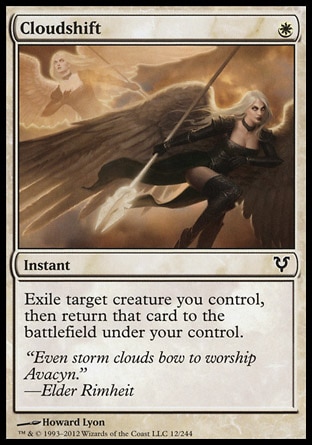
Cloudshift effect exiles a creature you control and immediately returns it back under your control. Note that you may “blink” an opponent’s creature you’ve “borrowed”. If you do, the creature will stay under your control for indefinite amount of time because Cloudshift’s effect has no time duration.
Suspend allows you to exile a card from your hand and then cast it on resolution of its second triggered ability. An exiled without time counters card with Suspend stays in exile, it cannot be cast without any additional effects.
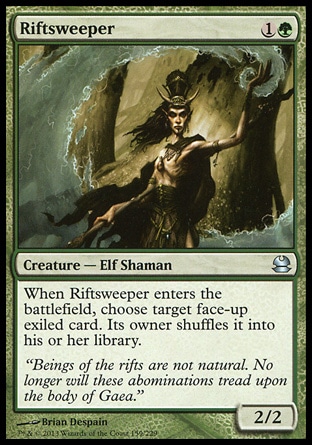
Riftsweeper’s triggered ability effect allows you to shuffle an exiled face-up card into the owner’s library. This is a fine way to get back a card exiled with Path to Exile or get rid of an opponent’s Suspended threat.
Tokens and spells cease to exist in exile the next time SBA are performed. Only cards stay in exile.
Cards in exile are not permanents and do not have a controller. If an effect refers to a controller of the exiled card, the owner is used instead.
Exile zone is a shared zone. As exile zone is a game zone, the exiled cards are still not “outside the game”. They cannot be returned with Wishes. Older cards wording uses “remove from the game” instead of “exile”. All those cards have been errated and the current wording is available in Oracle.
Exile zone is an open zone, this means that all players may see the face card of the exiled cards unless the cards were exiled face down.
Duplicant’s trigger exiles a card face up.
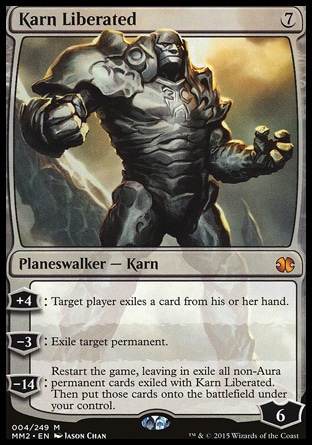
Karn’s loyalty abilities exile cards/permanents face up.

Fiend of the Shadows’s ability also exiles a card face up.
Cards exiled face down have no characteristics, but spells and abilities that exiled them allows to cast them. If a player casts an exiled face down card, he or she turns it face up right before moving it to the stack in order to cast. No one can respond to this action. In case a card is cast face-down (using Morph ability, for example), its face, naturally, is not revealed. Note that if an effect or a rule allows a player to see any face-down card in an open zone, that player may access this information until the end of game.
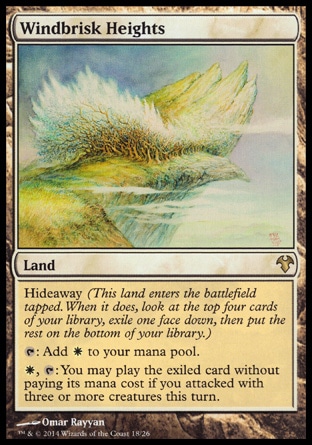
Hideaway is a very interesting mechanic that manipulates with exiled cards. It gives the exiled face down card ‘Any player who has controlled the permanent that exiled this card may look at this card in the exile zone’.
This means that if an opponent steals your Windbrisk Heights, both he or she and you may look at the card at any moment.
Naturally, only the current controller (or the player that controls the current controller) of the Heights may activate its ability.
Whenever a card changes the zone it becomes a new object that has no memory of its previous existence.
An exiled permanent loses any counters it had on the battlefield and leaves any Auras or Equipment attached to it behind. Any unattached Auras then are put into the graveyard the next time SBA are performed, Equipment are left on the battlefield.
There are, of course, some exceptions. The text of the effect will explicitly tell you about them.
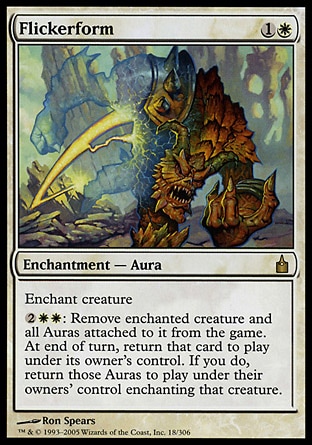
For instance, Flickerform’s activated ability exiles not only the enchanted creature, but also all the Auras attached to it. Creature card and Aura cards exist separately in exile zone. On resolution of the created delayed trigger the creature card is first returned to the battlefield. If this action is successful, all exiled with Flickerform’s ability Auras also return to the battlefield, become attached to the creature and receive a new timestamp.
If the exiled creature was a token, it can’t return to the battlefield, so all exiled Auras stay in the exile.
Cards in exile may have counters of their own. Suspended cards may have time counters, or a special effect may state that an object keeps the counters, check out Skullbriar, the Walking Grave.
On resolution of Fiend of the Shadows’s triggered ability a continuous effect is created that is active as long as the exiled card stays in the exile. Note that Fiend of the Shadows doesn’t need to be on the battlefield for you to be able to play the exiled card. It is also irrelevant who currently controls Fiend of the Shadows. “You” in the ability text refers to the controller of the ability, the player that controlled Fiend of the Shadows when the ability had triggered.
The effect allows to play an exiled card. “Play a card” means both “cast a spell” or “play a land” whatever is relevant.
As the effect created is continuous casting of the spell follows the normal procedure:
- You need priority to start casting;
- Creature, Artifact, Enchantment, Sorcery and Planeswalker spells can be cast only during the main phase of your turn and only if the stack is empty;
- Land can only be played during the main phase of your turn if the stack is empty and only once per turn.
Compare:
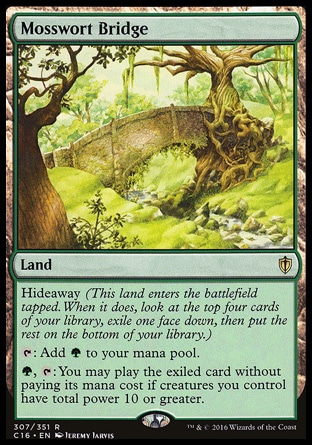
Mosswort Bridge ability allows you to play a card on its resolution. You may play any card this way with the only exception: a land can’t be played during the opponent’s turn regardless of the circumstances.

Fiend of the Shadows’s ability allows playing the exiled card as long as it remains in the exile zone, that’s why the normal rules are applied.
Spellcasting follows the normal rules and includes moving it to the stack from the exile zone right after spell announcement.
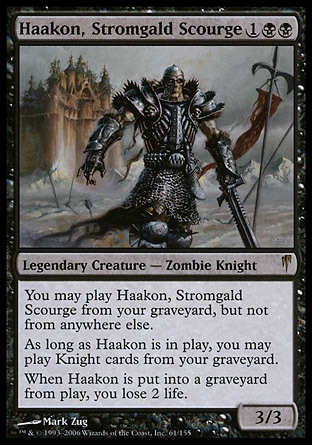
Haakon, Stromgald Scourge may be cast only from the graveyard. Fiend of the Shadows’s ability effect can’t overcome this ability, because the forbidding effect always wins.
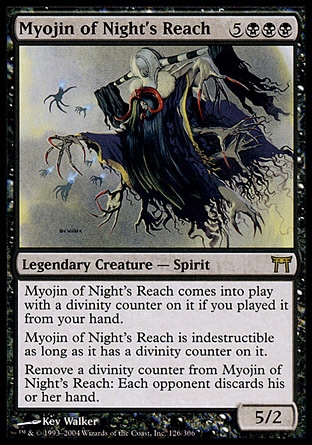
Myojin of Night’s Reach cast from the exile will enter the battlefield without divinity counters.
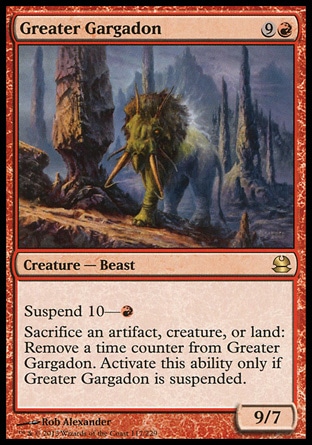
A creature card exiled with Fiend of the Shadows’s ability does not gain Suspend nor receives time counters, so you’ll have to hardcast Gargadon for {9R} and it won’t enter the battlefield with Haste.
The choice of targets, payment of the cost and other steps of the spellcasting are followed in a usual order. I recommend you to check out this order.
Casting a split card without Fuse you’ll have to choose a half that will go to the stack.
You may choose to cast a card face down if ability allows it.

You may pay any additional or alternative costs if the static abilities that allow doing that work on the stack.
Note that Fiend of the Shadows’s ability only allows you to play a card, you are not allowed to use its other abilities. You may not Cycle a card in exile, for example.
Regeneration
Fiend of the Shadows’s third ability is an activated ability. To activate it you must pay its activation cost, which is “Sacrifice a Human”. You may sacrifice any permanent with creature type Human (see the beginning of this column). It is irrelevant if a sacrificed creature had any other creature type as far as it had Human type.
On resolution of this ability a regeneration shield is created. This shield replaces destruction of Fiend of the Shadows with removing all damage marked on it, tapping it and removing it from the combat.
Regeneration cannot return a creature from the graveyard. If it died, it’s too late to regenerate it. To save a creature you must create a shield before it is destroyed. It is irrelevant how the creature was destroyed: whether an effect destroyed it directly, or lethal damage was dealt to it. It means that you should activate and resolve Fiend of the Shadows ability before combat damage is distributred, or before a spell or ability resolves that destroys it or deals lethal damage to it.
Sacrificing a creature is not the same as destroying it. Regeneration shield doesn’t work here. You can’t sacrifice a creature and save it with regeneration.
A regenerated creature is not put into graveyard, because the destruction is replaced. No ability that checks for a creature leaving the battlefield triggers. The creature does not die!
Note that “lethal” damage is only defined for a creature with toughness above 0. If the creature’s toughness is 0, it is put into the graveyard the next time SBA are performed. Regeneration cannot save the creature with toughness 0 or less.
Creating a regeneration shield does not cause the creature to become tapped. Resolution of Fiend of the Shadows ability creates this shield. It is applied the next time the creature is destroyed, it’s then that the creature becomes tapped. If the creature is already tapped (if it’s attacking for example) this part of the effect is simply ignored. If the creature wasn’t in combat, the part of the effect that removes it from the combat is also ignored.
A creature may have multiple regeneration shields. They are used one at a time, one per destruction. There are exceptions: if a source with Deathtouch deals 3 or more damage to Fiend of the Shadows, there are 2 state-based actions that try to destroy the creature. As all SBA are performed simultaneously and result in a single event, and, according to the rules, similar results from multiple SBA performed at the same time are replaced by a single replacement effect, you’ll only need one regeneration shield to save Fiend of the Shadows.
Unused regeneration shield ceases to exist at the end of turn. If you resolved Fiend of the Shadows ability and during that turn nobody tried to destroy it, you’ll have to create a new shield the next turn.
If an effect says that creature cannot be regenerated, regeneration shield doesn’t work.
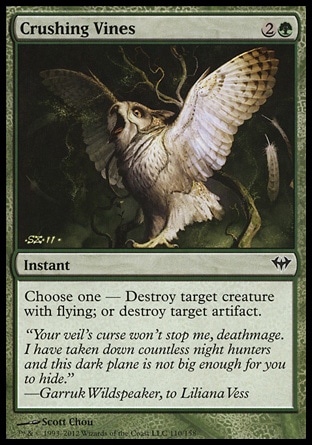
Regeneration shield will save Fiend of the Shadows from Crushing Vines.
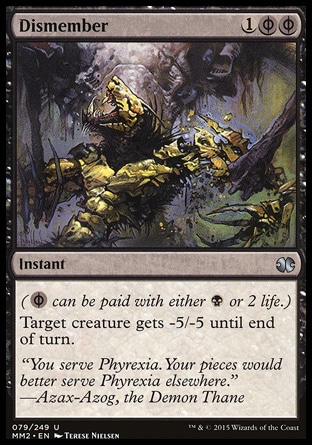
Dismember will cause Fiend of the Shadows’s toughness to drop below 0, regeneration won’t save the vampire from dying.

Wooden Stake triggered ability says that the creature cannot be regenerated, it will be destroyed even if it had regeneration shield.
- ⇑ Wishes — is a cycle of cards that has the word “Wish” in their name (e.g. Burning Wish). These cards allow you to get a card you own from outside the game and put it into your hand. In tournament Magic cards you own from outside the game are only the cards you have in your registered Sideboard.
- ⇑ Rules do not forbid casting sorceries at any time outside of its controller’s main phase. Rules tell us that normally players are only allowed to do it during the main phase of their turn and if the stack is empty (CR 307.1). Of course, if an effect allows or prescribes a player to cast a spell, that player is allowed to cast a sorcery even if it’s not his or her main phase.
- ⇑ No player receives a priority after the combat damage has been assignment but before it is dealt, so nobody gets a chance to cast spells or activate abilities at this point.
Translated by Lev Kotlyar

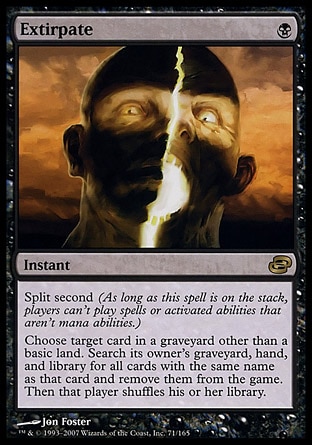

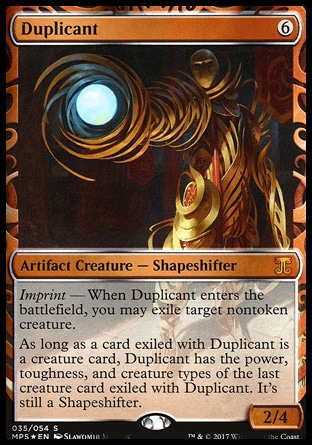
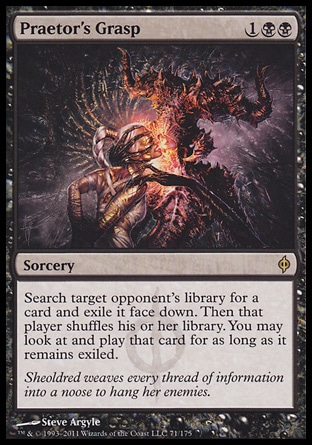
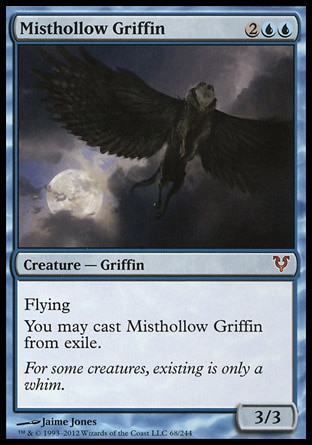

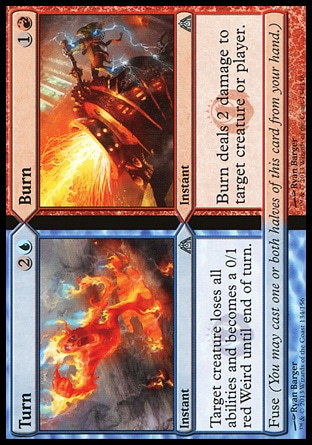
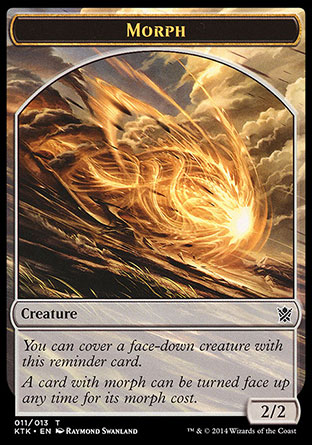
If your Misthollow Griffin was exiled face down by the enemy’s Praetor’s Grasp, for instance, it has no characteristics. This means that it doesn’t have an ability that allows to cast it from exile. So, although you are still its owner, you cannot look at that card nor cast it.
If Misthollow Griffin was exiled with Oblivion Ring’s first triggered ability, it is exiled face up, and its owner may cast it from exile thanks to the Griffin’s own static ability.